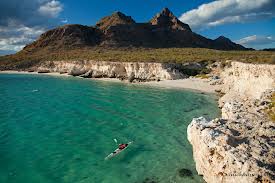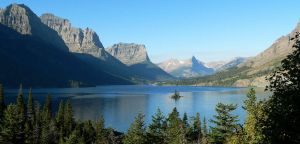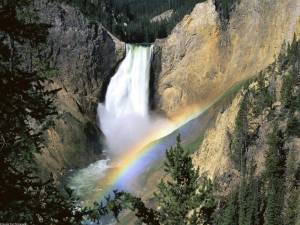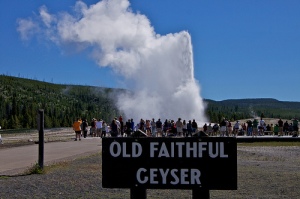Blog Archives
Throughout America: 20 Years of Personal Discovery – Chapt. 10
Chapt. 10
Glaciers and Steam in Montana
I often wondered why Montana was nicknamed “Big Sky Country” but when I arrived there to see for myself, I discovered maybe part of the answer. Montana, derived from the Spanish meaning of the word mountain, is one of the least populated states in America. Ranking 48 in population density, Montana has less than a million residents despite being the 4th largest state. The air is clean and refreshing, and pollutants very minimal, allowing clear skies that seem to go on forever.
There are well over 3,000 named lakes in Montana, varying in size. The largest fresh water lake in the west is Flathead Lake, and at about 195 square miles, fishing there and at hundreds of others are second to none in the nation. It’s also rather deep for a freshwater lake at about 370 feet in the deepest parts. About 30 miles from Glacier National Park, Flathead Lake sports some of the clearest, cleanest water in America. And it should come as no surprise that the lake is what’s left of an ancient glacial dam formed thousands of years ago during the last ice age.
The new friends I met in Montana were more than willing to be my guide in this enormous, beautiful part of the country. Their first suggestion was Glacier National Park. Located about 150 miles directly north of Missoula, Montana, and hugging the Canadian border, the park was just the beginning of what Montana has to offer both visitors and residents alike. I did my homework before arriving at the park, and when I arrived there, I was looking at mountains that had began forming some 170 million years ago.
Covering about a million acres of land and water, Glacier National Park is dubbed the Crown of the Continent Ecosystem for a very good reason. This strictly protected land contains about 1,000 plant species and several hundred types of animals. As with most of Montana, there is little to no pollution, and the park has about 200 waterfalls of varying sizes. What’s more, the area is known for its wild mammals, such as moose, grizzly bears and the endangered Canadian minx.
Like most of the region in the northwest, the area was first inhabited by native Americans, and archeological evidence suggests that it may have been as long as 10,000 years ago in Glacier National Park. Modern lineage to these prehistoric tribes include the Salish, Flathead, Cheyenne and Shoshone.
Months after moving to Montana, and after seeing the points of interest nearest to me, it was time to see the big tamale of Montana’s attractions, Yellowstone National Park. The park is located in southern Montana and Wyoming, most of which is in Wyoming. As was the case with other places I had just heard of or saw on television, I wasn’t entirely sure of what I’d see up close compared to text books describing geysers, wild grazing bison and Old Faithful herself. Myself and a few friends packed the SUV full of what we needed for an entire day of exploration in God’s country.
The same as Glacier National Park, Yellowstone was inhabited by humans over 10,000 years ago. However, these people came before Native American’s and are described as Paleo-Indians of the Clovis people lineage. Obsidian rock, very unique to the area, provided a source of tools and weapons to these early people. Some of these tools and weapons have been found as far away as the Mississippi valley, lending evidence that trade was going on among tribes in other regions.
I was in for a surprise when I laid eyes on the park for the very first time. I also got a very valuable geography and science lesson. Yellowstone is comprised of about 3,500 square miles of wonder, including hot springs, wilderness and large mammals that include grazing herds of bison, bears, elk, moose and wolves.
What makes Yellowstone beautiful also makes it very dangerous. The entire area is situated above a giant caldera, or super volcano, that last erupted about 600,000 years ago. Natural springs combine with the hot lava below the surface to ultimately form the geysers visitors see spewing in to the air. Scientists believe that the caldera below Yellowstone is due for another eruption based on its past activity, and when the caldera does eventually erupt, the results are predictably going to be a catastrophe that could change the climate of the world, or have a nuclear winter as a result. This could mean life as we know it would change for the worse for many decades.
When most people give Yellowstone a thought, Old Faithful comes to mind. The geyser was named officially by the Washburn Expedition in 1870. Much of this area had gone unexplored until that time, being passed up earlier in the 1800’s by the Lewis and Clarke Expedition. Although Old Faithful is not the biggest geyser in the park, it is the most reliable in its timing. It erupts, ejecting hot, scolding water into the air about 100 to 180 feet every 35 to 120 minutes. The blasts of hot water can last anywhere between 90 seconds and 5 minutes.
My visit to Yellowstone cannot all be covered in this series, as one would have to experience it themselves to see the entire picture. It’s beyond imagination, and an experience that ranks right up there with the Grand Canyon and other wondrous points of interest. But beauty takes all forms, as will be described in the next adventure.



